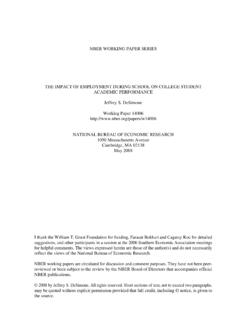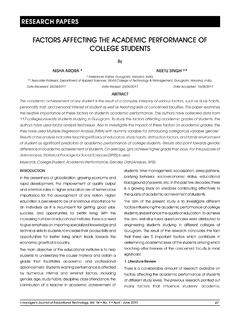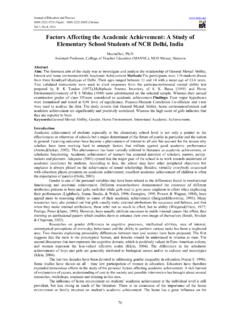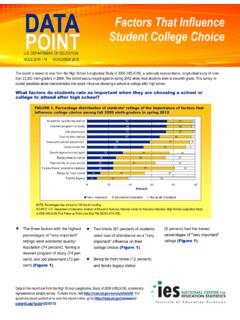Transcription of Factors affecting teacher retention: qualitative investigation
1 Factors affecting teacher retention: qualitative investigation Research report March 2018 CooperGibson Research 2 Contents List of tables 4 Executive Summary 5 Introduction 5 Key Findings 6 Reasons for leaving teaching 6 Possible solutions offered by interview participants 6 Reactions to discussion prompts 7 Likelihood of returning to teaching 8 1. Introduction 10 Methodology 10 Phase one 10 Phase two 12 2. teacher Expectations 18 Reasons for becoming a teacher 18 Expectations of teaching 18 Impressions of the teaching role 19 3. Reasons for Leaving Teaching 21 Workload 21 Stress and ill health 22 School leadership, policy and approaches 23 Enforcement of inflexible teaching policies 25 Government policy 25 Professional development and pay 26 4.
2 Making the Decision to Leave Teaching 28 Considerations and concerns when deciding to leave 29 Comparison of teaching with new job/career 30 5. Incentives to Remain in or Return to Teaching 32 Potential solutions for supporting the retention of teachers 32 Improving in-school support for teachers 32 3 Greater focus on professional development 33 Reducing workload at school level 34 Improved working conditions 36 Professional recognition and greater autonomy 36 Response to discussion prompts 37 A support system for teachers in the first five years of teaching 38 Eliminating unnecessary workload 40 A trimmed down teaching post 41 6.
3 Likelihood of Returning to Teaching 45 Teachers still in the profession 46 Teachers actively returning to the profession 47 7. Summary of Findings and Conclusions 48 Reasons for leaving the profession 48 The experiences of early career teachers 49 Potential solutions to encouraging teachers to stay in the profession 49 Teachers suggested solutions 49 Feedback on discussion prompts 52 Likelihood of returning to teaching 54 4 List of tables Table 1: Phase 2 sample breakdown by subject group 14 Table 2: Phase 2 sample breakdown by subject 15 Table 3.
4 Phase 2 sample breakdown by length of service 16 5 Executive Summary Introduction From January to March 2017, the Department for Education (DfE) administered an online survey targeted at former teachers and disseminated through Tes (formerly known as the Times Educational Supplement) and subject associations. The survey gave a quantified account of the range of reasons for leaving teaching and explored the current employment status of former teachers. Following this survey,1 the DfE commissioned CooperGibson Research (CGR) to conduct in-depth qualitative research into teacher retention.
5 The purpose of the project was to further explore and improve understanding of the reasons why teachers leave the profession2 and what would encourage them to remain in, or return to, teaching. A qualitative approach using telephone and face-to-face interview techniques was used to explore, in depth, the reasons for leaving teaching and to discuss potential solutions and ideas. The project took place over two key phases: the first was a smaller pilot phase exploring emerging findings around key drivers and reasons for leaving, and the second consisted of full qualitative fieldwork, focusing more on potential solutions.
6 In total 101 in-depth interviews were completed via face-to-face and telephone methods 21 interviews in phase one and 80 in phase two. The interviews were conducted with a sample of teachers who had left teaching within the last two years, selected from those who responded to the DfE s self-selecting survey of former teachers, which took place in January-March 2017. Phase one interviews took place between 20th April 10th May 2017; phase two interviews took place throughout July 2017. Throughout the report, former teachers have been referred to as teachers . 1 See Analysis of school and teacher level Factors relating to teacher supply (September 2017), section 4, which provides findings of the survey.
7 Workload, government policy, and lack of support from leadership were cited as the three main reasons for leaving and 85% of respondents said that they didn t plan to or were undecided about going back into teaching. , 2 The research focuses on staff who have left state-funded schools in England, including local authority maintained schools, academy schools (including free schools, studio schools and university technology colleges) and city technology colleges, special schools and pupil referral units. 6 Key Findings Reasons for leaving teaching Workload remains the most important factor influencing teachers decisions to leave the profession and most suggested solutions to addressing retention were linked to workload in some way.
8 There is evidence that early career teachers3 made the decision to leave the profession quickly, typically within three months of when they first started to consider leaving. By contrast, more experienced teachers were more likely to consider their decision over one to two years. Teachers decisions to leave the profession were generally driven by the accumulation of a number of Factors , over a sustained period of time. However, for some teachers, there had been a specific trigger point, for example around teaching performance resulting in involvement from the senior leadership team (SLT), feeling undervalued after an issue had been highlighted or a specific behavioural incident involving pupils and parents/carers4.
9 Possible solutions offered by interview participants Teachers found it challenging to provide solutions to retention issues or suggestions for how issues they had faced could have been resolved. Nevertheless, they did provide some top-level ideas for consideration. It is important to note that former teachers possible solutions cannot be considered generalisable and applicable to the wider teaching profession due to the relatively small sample of teachers that were involved in this research. These related to: Improving in-school support for teachers greater levels of support and understanding from SLT was needed, for example, in terms of the management of pupil behaviour, and the ability to have open and honest conversations.
10 This would help support teachers relationships with their SLT and reduce feelings of pressure in terms of scrutiny, accountability and workload. Considerations would be how the message to senior leaders and teachers can be strengthened to dispel the myths around inspection and the commitment to reduce workload. This would 3 Teachers who have been in the profession for less than five years. 4 The DfE s survey of former teachers found that 61% of respondents said that it was a single factor or event that triggered their departure, published in Analysis of school and teacher level Factors relating to teacher supply (September 2017), chapter 4.















